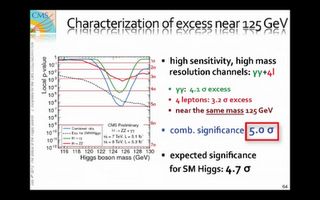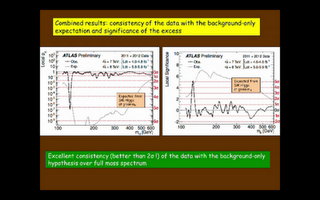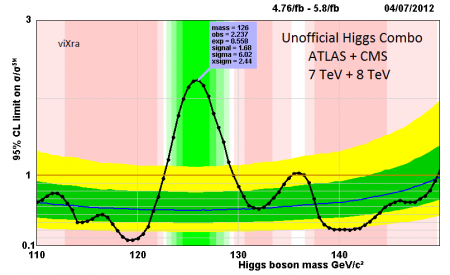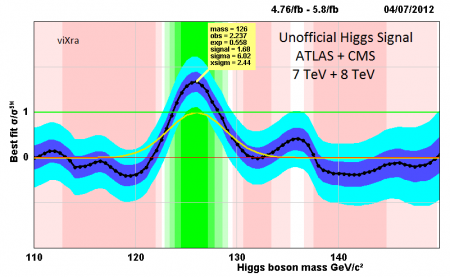A few minutes ago, one of the most important announcement in particle physics in the past 30 years was made by scientists working with the Large Hadron Collider (LHC) at CERN, in Geneva. For decades, tens of thousands of physicists have been involved in an intense experimental search for the "holy grail" of particle physics, the Higgs Boson. It has now been discovered.
I'm a theoretical particle physicist, whose first paper in 1978 was about the Higgs. Since then, I've written over 100 published papers on the Higgs (in the Standard Model and in various alternatives). Had the LHC not found it, much of my career would have been spent on something that doesn't exist. It would be hard to describe how I'm feeling right now....
In four earlier diaries, I discussed the status of the Large Hadron Collider's (LHC) search for the Higgs. The first diary, last July, described what the Higgs boson is and why it is so important. The second diary, a week later, gave the first results presented from the LHC. No Higgs boson was found, but the range of possible masses was narrowed. In November, the final update on all of the data collected through last August, was presented in the third diary. The fourth discussed an announcement last December, covering all of last year's data, in which the first solid evidence for the Higgs was presented. Although solid, it wasn't enough to announce a discovery. All four diaries got a lot of comments and made the rec list. This may be the last, since the discovery has finally been made.
In this diary, I will give a rough idea of why the Higgs is so important, and what the new results are (and what they mean), and what will be done in the future. For a more detailed description, written at a level that I think is comprehensible to the layman, please look at the first diary above (some of the text in that diary is copied below).
And now, in honor of our European colleagues, I invite you to go below the Great Orange Croissant for the details.
The Standard Model
One of the most successful theories in science is the "Standard Model" which describes all forces in nature (except gravity). The electromagnetic force (responsible for light), the weak force (responsible for radioactive decay) and the strong force (responsible for holding atomic nuclei together) are all described succinctly in the Standard Model. It makes hundreds of experimental predictions that have been verified in many cases to better than a part in a thousand. Yet there is one piece missing--the Higgs boson.
What is the Higgs boson, and why is it so important?
One of the long-standing mysteries in physics is the origin of mass. While most people tend to think of mass in terms of gravity, it is actually independent of gravity (in zero gravity conditions, it is still harder to push Rush Limbaugh, who has a large mass, than a ping-pong ball, which has a small mass). In particle physics, we measure mass in units of "electron volts". An electron-volt is a unit of energy, and Einstein's famous relation between energy and mass relates a particle's mass to its energy. All of the known elementary particles have masses, which have a huge range of values, ranging from fractions of an electron volt for neutrinos up to around a hundred billion electron volts for the heaviest quark (the top quark). The values of all of the masses are found at http://www.cpepweb.org/... . Nobody knows why the masses have the values they do. One could just say "well, that's the way things are". But there is a problem---without a Higgs boson, the mathematics of the Standard Model would predict that the masses of the fundamental elementary particles are zero.
So what is the Higgs? Physicists assume that everywhere in space there is a field called a "Higgs field". On Earth, we all know that everywhere in space there is something called a "magnetic field". The Higgs field is similar, but it has no preferred direction and is constant everywhere in the Universe. When particles move through the Higgs field, they interact with it and the main effect of this interaction is to give these particles a mass. All particle masses arise from the particle's interaction with the Higgs field, and heavy particles interact more strongly with the field than light particles do. Let me use an analogy to explain this further.
Suppose there is a reception at Netroots Nation, and a loosely-packed crowd of Kossacks is in a room. If I walk into the room, nobody really knows me so I can walk right through without much slowing---so I have little resistance to my motion. Now suppose Markos walks in. Everyone will go towards him, and it will take much longer for him to walk through the room. He will have more "mass", it will be harder for him to move quickly.
That is the Higgs field. Particles that interact strongly with the field (like Markos) have a lot of mass; those that interact weakly (like me) have little mass. What about the Higgs boson? Suppose that long before Markos enters the room, someone sees him entering the building. The word of his imminent arrival will spread through the room, i.e. information will go from one point to another. Note that Markos is not there---the ordinary "particles" are absent--and yet information still travels. In particle physics, information is transmitted by particles (or waves--but wave-particle duality is a much more complicated subject than I can discuss here). In the case of the Higgs field, the particle is called the Higgs boson. It represents an "excitation" of the Higgs field. If you apply enough energy to the Higgs field, you will get it "vibrating", and that corresponds to creating a Higgs boson.
What is the mass of the Higgs? Alas, the theory doesn't specify it precisely, although until a few years ago physicists thought that its mass cannot be less than 115 GeV or more than 500 GeV (where "GeV" means a billion electron volts, roughly the mass of a proton)
How is a Higgs detected?
The details are given in the first diary. Basically, you slam two very high energy beams of protons together, and once every trillion collisions or so, you produce a Higgs boson. It decays rather quickly into two particles. These particles are then detected and precise measurements of their energies and momenta tell you that it came from a single object (and tells you the mass of the object). For the LHC this year, the primary decays of interest are into two photons (often called gammas---these are associated with electromagnetism) and Z's (associated with the weak force). Photons and Z's are very well understood and easy to detect. Unfortunately, only about one in several hundred Higgs bosons decays into gammas or Z's, so you need to make a lot of them.
What was the situation before this announcement?
In August, 2011 (second diary above), the two detectors at the LHC, called ATLAS and CMS, reported that they ruled out most of the mass region between 145 GeV and 400 GeV. That left a window between 115 and 145 GeV, and a window between 400 and 500.
In November, 2011 (third diary), the results of the two detectors were combined, with similar results. The entire region between 140 and 400 was excluded.
In December, 2011 (fourth diary), the experiments EXCLUDED the entire range from 128 GeV to 500 GeV. The only place left for the Higgs to hide was in the narrow range from 115 GeV to 128 GeV. However, the most exciting result is that they saw a lot of gammas and Zs which seemed to come from a particle with a mass of 125 GeV. This was the first evidence that a Higgs boson might be there.
One last point before discussing today's announcement. When scientists report an experimental result, they report both the result and the "experimental error". When looking for a bump over a background, there is always the chance that the background will happen to fluctuate up (like a fair coin giving 53 heads in 100 tosses). In describing the significance of a result, physicists use a quantity called "sigma". This is familiar to statisticians-- for any experimental result, there is
A 68% chance of being within one sigma of the actual value
A 95% chance of being within two sigma of the actual value
A 99.7% chance of being within three sigma of the actual value
A 99.99994% chance of being within five sigma of the actual value.
With the Higgs search, one compares to the no-Higgs hypothesis. If a Higgs is there, there will be a discrepancy with the no-Higgs hypothesis. With only a little data, it will be a small discrepancy, and might be only one sigma (which could just be a statistical fluctuation). As more data comes in, sigma gets smaller, and the number of sigma in the discrepancy will grow, providing more and more evidence that a Higgs is there.
You might think that three sigma (99.7% chance) is close enough, but errors are sometimes underestimated, and the physics community long ago decided that a three sigma deviation would be considered "evidence" and a five sigma deviation would be needed for "discovery". I know of a few three sigma announcements that have faded away, but five sigma (note for experts--this assumes there are no large systematic errors) do not generally go away.
The results announced from last year's run, combining all possible decays, gave evidence at the 3.5 sigma level for ATLAS and the 2.9 sigma level for CMS. They now have more than twice the data.
Today's announcement
CMS speaks first (Joe Incandela). They see a huge spike in the number of two-gamma events at precisely 125 GeV. The significance in the gamma-gamma result is 4.2 sigma.
ZZ also shows a spike at 125 GeV. Significance is 3.2 sigma.
Combining the two results gives a result of exactly 5.0 sigma. THIS IS DISCOVERY. And ATLAS still is yet to speak.
I'll keep live-blogging, and will show slides as soon as available. But this is it. The Higgs has been discovered!
Slide from CMS making the announcement:

Mass from CMS is 125.3 +- 0.6 GeV
When CMS looks at all the other decay modes, the results weaken very slightly to 4.9 sigma. But with ATLAS, that clearly is discovery.
Fabiola Gianotti is now speaking for ATLAS
CERN press release just out:
CERN experiments observe particle consistent with long-sought Higgs boson
Geneva, 4 July 2012. At a seminar held at CERN1 today as a curtain raiser to the year’s major particle physics conference, ICHEP2012 in Melbourne, the ATLAS and CMS experiments presented their latest preliminary results in the search for the long sought Higgs particle. Both experiments observe a new particle in the mass region around 125-126 GeV.
“We observe in our data clear signs of a new particle, at the level of 5 sigma, in the mass region around 126 GeV. The outstanding performance of the LHC and ATLAS and the huge efforts of many people have brought us to this exciting stage,” said ATLAS experiment spokesperson Fabiola Gianotti, “but a little more time is needed to prepare these results for publication.”
"The results are preliminary but the 5 sigma signal at around 125 GeV we’re seeing is dramatic. This is indeed a new particle. We know it must be a boson and it’s the heaviest boson ever found,” said CMS experiment spokesperson Joe Incandela. “The implications are very significant and it is precisely for this reason that we must be extremely diligent in all of our studies and cross-checks."
“It’s hard not to get excited by these results,” said CERN Research Director Sergio Bertolucci. “ We stated last year that in 2012 we would either find a new Higgs-like particle or exclude the existence of the Standard Model Higgs. With all the necessary caution, it looks to me that we are at a branching point: the observation of this new particle indicates the path for the future towards a more detailed understanding of what we’re seeing in the data.”
The results presented today are labelled preliminary. They are based on data collected in 2011 and 2012, with the 2012 data still under analysis. Publication of the analyses shown today is expected around the end of July. A more complete picture of today’s observations will emerge later this year after the LHC provides the experiments with more data.
The next step will be to determine the precise nature of the particle and its significance for our understanding of the universe. Are its properties as expected for the long-sought Higgs boson, the final missing ingredient in the Standard Model of particle physics? Or is it something more exotic? The Standard Model describes the fundamental particles from which we, and every visible thing in the universe, are made, and the forces acting between them. All the matter that we can see, however, appears to be no more than about 4% of the total. A more exotic version of the Higgs particle could be a bridge to understanding the 96% of the universe that remains obscure.
“We have reached a milestone in our understanding of nature,” said CERN Director General Rolf Heuer. “The discovery of a particle consistent with the Higgs boson opens the way to more detailed studies, requiring larger statistics, which will pin down the new particle’s properties, and is likely to shed light on other mysteries of our universe.”
Positive identification of the new particle’s characteristics will take considerable time and data. But whatever form the Higgs particle takes, our knowledge of the fundamental structure of matter is about to take a major step forward.
ATLAS results: For the gamma-gamma, they see a huge peak at the same place as CMS. Significance is 4.5 sigma, which is a little stronger than CMS. The rate compared to the standard model prediction is 1.9 +- 0.5, which is a little high. Could be new physics, or could be a fluctuation. We'll know by the end of the year.
For ZZ, lots of events. She is showing actual "pictures" of the events. The excess is 3.4 sigma, also very slightly above CMS. Rate is comparable to that expected.
Putting them together, the final result from ATLAS is over 5 sigma -- crowd breaks into applause. It is 5.1 sigma. Combining the other possible signals, they get 5.0 sigma. Independent of CMS, ATLAS has discovered the Higgs!
Their mass is 126.5 GeV, and they don't list the uncertainty.
Result from ATLAS is here

At http://blog.vixra.org you can see a whole bunch of pictures and the latest analysis.
Tonight, all of America will celebrate with fireworks!
From the blog.vixra.org site, a combined results for the two experiments. It is over 6 sigma.

The blue line is what you expect if there is no Higgs. The black line is the data.

Here, the red line is the no-Higgs limit. The green line is the Standard Model value for a given mass. The yellow line is what one expects for a 126 GeV Higgs. The black line is the data and the bands are the 1 sigma and 2 sigma regions. Clearly, the no-Higgs hypothesis is way off. The signal is actually a little high (about 2 sigma), but that's possibly just a statistical fluctuation --if it is a real discrepancy, then the Standard Model would have to be modified.
What next?
Now that the Higgs has been discovered, it is critical to measure its properties. We know the Standard Model is incomplete. It does not explain dark matter or dark energy, for example. There are many, many extensions of the Standard Model, and most theorists have worked on those over the past couple of decades. (Supersymmetry is the most well-known--but that's another diary...). In most of these extensions, a Higgs at 125 GeV is perfectly ok, but the distribution of the decay products differ slightly from the Standard Model (often by 10-20%). So it is critical to measure those. This will be the focus (as well as looking for new particles, of course) at the LHC.
The LHC runs until October. It then shuts down for 15 months, and then starts at roughly twice the current energy. The total amount of data will increase by a factor of 100.
There is a "nightmare scenario". That occurs if the LHC studies the Higgs and finds no discrepancy with the Standard Model and no new particles. What do we do then? (I think it's unlikely, and we won't really know until 2020....). My guess is that this is just the beginning of a new era.


